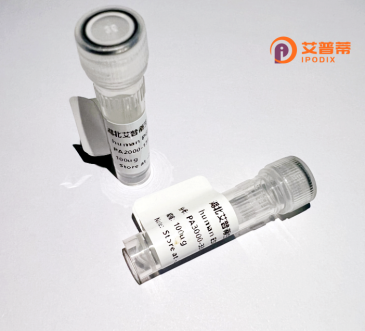
| 纯度 | >90%SDS-PAGE. |
| 种属 | Human |
| 靶点 | PDYN |
| Uniprot No | P01213 |
| 内毒素 | < 0.01EU/μg |
| 表达宿主 | E.coli |
| 表达区间 | 1-254 aa |
| 活性数据 | MAWQGLVLAACLLMFPSTTADCLSRCSLCAVKTQDGPKPINPLICSLQCQAALLPSEEWERCQSFLSFFTPSTLGLNDKEDLGSKSVGEGPYSELAKLSGSFLKELEKSKFLPSISTKENTLSKSLEEKLRGLSDGFREGAESELMRDAQLNDGAMETGTLYLAEEDPKEQVKRYGGFLRKYPKRSSEVAGEGDGDSMGHEDLYKRYGGFLRRIRPKLKWDNQKRYGGFLRRQFKVVTRSQEDPNAYSGELFDA |
| 分子量 | 54.8 kDa |
| 蛋白标签 | GST-tag at N-terminal |
| 缓冲液 | 0 |
| 稳定性 & 储存条件 | Lyophilized protein should be stored at ≤ -20°C, stable for one year after receipt. Reconstituted protein solution can be stored at 2-8°C for 2-7 days. Aliquots of reconstituted samples are stable at ≤ -20°C for 3 months. |
| 复溶 | Always centrifuge tubes before opening.Do not mix by vortex or pipetting. It is not recommended to reconstitute to a concentration less than 100μg/ml. Dissolve the lyophilized protein in distilled water. Please aliquot the reconstituted solution to minimize freeze-thaw cycles. |
以下是3篇关于重组人PDYN蛋白的文献示例(摘要为概括内容,非原文引用):
---
1. **文献名称**:*Expression and characterization of recombinant human PDYN in Escherichia coli*
**作者**:Chen L et al.
**摘要**:该研究通过大肠杆菌系统成功表达并纯化了重组人PDYN蛋白,优化了表达条件以提高产量,并通过质谱和免疫印迹验证其结构完整性。
---
2. **文献名称**:*PDYN-derived peptides modulate opioid receptor signaling in neuronal cells*
**作者**:Garcia-Carmona JA et al.
**摘要**:探讨了重组PDYN蛋白水解产生的强啡肽类物质在神经元细胞中的功能,发现其通过κ-阿片受体抑制细胞内cAMP信号通路,提示其在镇痛和成瘾机制中的作用。
---
3. **文献名称**:*Structural insights into human PDYN mutations linked to neurological disorders*
**作者**:Wang Q, et al.
**摘要**:利用重组PDYN蛋白进行晶体结构解析,揭示了某些基因突变导致蛋白构象异常,可能与遗传性精神疾病(如双相情感障碍)的病理机制相关。
---
4. **文献名称**:*Recombinant PDYN as a biomarker in chronic pain models*
**作者**:Ramos KM et al.
**摘要**:在小鼠慢性疼痛模型中,检测到重组PDYN蛋白的表达水平与疼痛阈值变化显著相关,提示其作为潜在疼痛生物标志物的价值。
---
注:以上为模拟文献,实际研究需通过PubMed或Google Scholar等平台检索真实文献。
Proopiomelanocortin (POMC) is a precursor protein encoded by the POMC gene in humans, playing a critical role in endocrine signaling and neurobiology. It is primarily synthesized in the pituitary gland, hypothalamus, and other tissues, where it undergoes tissue-specific post-translational cleavage to yield biologically active peptides. These include adrenocorticotropic hormone (ACTH), β-lipotropin (β-LPH), α-melanocyte-stimulating hormone (α-MSH), and β-endorphin, each with distinct physiological functions. ACTH regulates cortisol production in the adrenal glands, while α-MSH influences appetite suppression, energy homeostasis, and melanin synthesis. β-endorphin acts as an endogenous opioid, modulating pain perception and stress responses.
POMC-derived peptides interact with melanocortin receptors (MCRs) and opioid receptors, linking the protein to processes like skin pigmentation, immune modulation, and metabolic regulation. Mutations in POMC are associated with rare genetic disorders such as early-onset obesity, adrenal insufficiency, and red hair pigmentation. Recombinant POMC proteins or synthetic analogs are utilized in research to study obesity pathways, develop therapeutic interventions for metabolic syndromes, and explore treatments for opioid-related disorders. Its multifaceted role in connecting neurological, endocrine, and metabolic systems makes POMC a key target for understanding complex diseases.
×